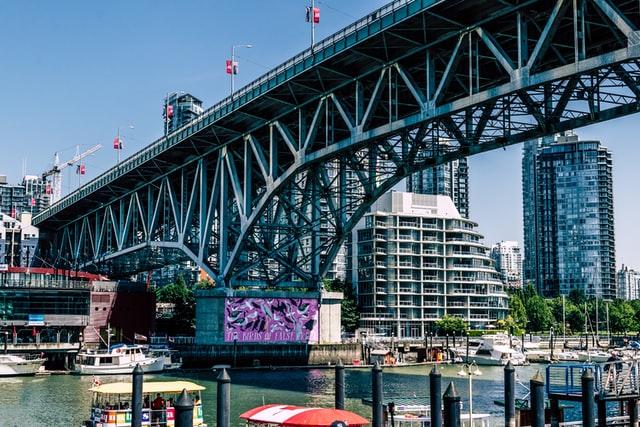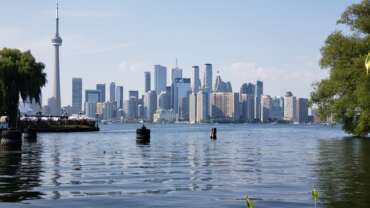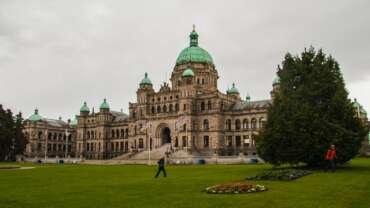Historical Sites in Canada
Though Canada is a relatively young country in an official sense (French and English settlers arrived during the Age of Exploration in the 15th and 16th centuries and laid down the roots for what would become modern-day Canada), indigenous peoples and other settlers were here long before that.
Canadian culture, including the preservation of its past through architecture, artifacts and natural relics, is showcased in many ways across the country. Historical sites representing the lives of indigenous peoples, European settlers, Vikings and even dinosaurs are open to the public and are excellent venues for discovering the country’s rich past.
Europeans landed first in eastern Canada, namely Quebec, so naturally the oldest settlements are there. Migration west came later. Here are a few of the top historical sites, located across the country.
L’Anse aux Meadows, Newfoundland
Long before Christopher Columbus boarded a ship, Vikings sailed across the Atlantic and arrived in North America. Proof of this mission can be found at L’Anse aux Meadows, an authentic 11th century Norse settlement in Newfoundland and Labrador, Canada’s most easterly province. These excavated remains are evidence of the first European presence in North America.
The site was excavated in 1960 when Norwegian explorer and writer Helge Ingstad and his wife, archaeologist Anne Stine Ingstad, searched the area. It was named a World Heritage site by UNESCO in 1978
This remarkable archaeological site consists of eight timber-framed turf structures built in the same style as those found in Norse Greenland and Iceland from the same period. In addition, many artifacts, including those related to iron smithing, a stone lamp and sharpening stone, are on display.
The thick peat walls and turf roofs appear to be a smart defense against the harsh northern winters. Each building and its rooms are set up to showcase different aspects of Norse life and interpreters dressed in Viking garb tell entertaining and informative tales.
Getting to L’Anse aux Meadows is not an easy feat. It is at the northern most tip of the island of Newfoundland, most easily accessible from the St. Anthony Airport, or a 10-hour drive from the provincial capital of St. John’s.
Ninstints, Haida Gwaii Islands, British Columbia
For the adventure minded who enjoy a dose of history and culture with their travel, Haida Gwaii, formerly the Queen Charlotte Islands, is a unique and compelling destination.
This archipelago on Canada’s west coast off of British Columbia is home to the UNESCO World Heritage Site SGang Gwaay (“Ninstints” is the English name).
Ninstints is a village site that features the largest collection of Haida totem poles in their original locations, many celebrated as notable works of art. They are being allowed to weather and decay in the lush temperate rainforest climate.
Archaeological evidence indicates that Haida Gwaii have been inhabited for thousands of years; however, small pox wiped out the population in the 1860s.
Today Haida watchmen guard the site and offer tours to a limited number of visitors each day.
Dinosaur Provincial Park, Alberta
Long before Canada was on the radar of European explorers, dinosaurs made this country their home. Evidence of their ancient Canadian residency remains in Dinosaur Provincial Park in Alberta.
Two hours east of Calgary is one of Canada’s most unique National Parks where dinosaur history meets a radical landscape of pinnacles and serpentine spires. Dinosaur Provincial Park is home to some of the most extensive dinosaur fossil fields in the world. Remnants of at least 35 species of dinosaur that lived here 75 million years ago when the area was a lush, sub-tropical forest can be toured by bus, on foot or through expeditions and other educational programs.
Be sure to include a visit to nearby Drumheller where the outstanding Royal Tyrell Museum boasts one of the most comprehensive and engaging dinosaur exhibits in the world.
Fortress of Louisbourg, Nova Scotia
The Fortress of Louisbourg is an unexpected treasure for visitors to Cape Breton, an island that is part of the province of Nova Scotia.
One of the busiest harbours in North America during the 18th century and one of France’s key economic and military centres in the New World, today the Fortress of Louisbourg is North America’s largest historical reconstruction.
Though the site was abandoned and fell to ruins in the 19th century, the Canadian government picked up the pieces in 1928, turning it into a national park. About a quarter of the town has been reconstructed, with the remaining parts still being probed for archeological goodies.
Visitors get a tangible sense of what life was like in the 1700s through displays, on-site interpreters in costume, and even a restaurant serving up traditional fare. The fortress is in the town of Louisbourg and part of the Parks Canada system of national parks.
Old Montreal, Quebec
Old Montreal is a part of downtown Montreal that has been preserved in much of its original state, with the oldest buildings dating back to the 1600s. This historic neighbourhood is a vibrant community and tourist attraction, with hotels, restaurants, shops, residences and commercial spaces.
Like Quebec City, Old Montreal is European in character. Cobblestone streets, a café culture and historic 17th- and 18th-century architecture all contribute to the quaint charm that stands out among cities in North America.
Old Montreal has a history dating back to 1642 when settlers from France landed at the edge of the St. Lawrence River and began to build a model Catholic community. The town became a major trading and military post—at one time surrounded by fortifying walls—and housed Canada’s parliament for a few years in the 1800s. This waterside community is today’s Old Montreal.
Halifax Harbour, Nova Scotia
Since the 1700s, the Port of Halifax has been a cornerstone of economic activity for the city, the region and the province as a whole. The Port’s strategic location made Halifax the perfect gateway into North America for settlers and shippers and military stronghold.
Today, visitors can explore a number of historical points of interest by visiting the port and its surrounding area.
The Maritime Museum of the Atlantic, for example offers a fascinating glimpse into such events as the Halifax explosion and the Titanic’s doomed voyage.
In addition, the Canadian Museum of Immigration at Pier 21 showcases the country’s immigration history, even offering copies of original landing documents for a small price.
Finally, a 10 minute walk away from the boardwalk, immerse yourself in Halifax’s military and colonial history with a visit to Citadel Hill. Standing high over the city and overlooking the wide open waters, it’s easy to understand why Citadel Hill was chosen as a military post site back in 1749 when Halifax was home to a few thousand British colonists.
Today, the citadel is part of Parks Canada and offers guided tours and activities, including musket demonstrations and cannon blasts.
Quebec City, Quebec
Quebec City offers an experience unlike any other in North America. Quebec City’s Old Town itself is a historical network of cobblestone walkways, well-preserved 17th century architecture and the only North American fortress walls that still exist north of Mexico — all of which has given the entire city status as a UNESCO World Heritage Site.
Quebec City was founded as the capital of New France back in 1608 and maintains much of its original composition, buildings and ambience.
Many of Quebec City’s top attractions tell the tale of not just Quebec’s but Canada’s history. It is on the grassy Plains of Abraham that the French and English battled for power in 1759. The small and picturesque Place-Royale is where the Indigenous people stopped to trade fur, fish and copper.
Visiting Quebec City is easy, as the city is primed to welcome thousands of visitors daily with an international airport and extensive network of hotels, restaurants and shops. A walking tour is the best way to get an overview of this fascinating city.
Fairmont Historic Railway Hotels, Various Locations across Canada
During the late 19th and early 20th centuries, when train travel was the most efficient way to cross the country, dozens of Canadian cities on the Canadian Railway route erected luxury railway hotels to accommodate train passengers. The historic grandeur of these hotels is unsurpassed in Canada and some, such as the Fairmont Banff Springs, remain luxury hotels by modern, worldwide standards. They have hosted major Hollywood stars and royals and politicians from around the globe.
The current owner of these hotels, Fairmont Hotels & Resorts, has restored a great number to their former glory, which is often a sprawling mix of architectural styles from French Gothic to Scottish Baronial. Guests can stroll the halls and soak up history by perusing the paintings, artifacts, and photos that adorn the walls.
Even if you don’t stay overnight, many of these celebrated hotels are worth visiting for afternoon tea or a drink at the bar. Some, like the Chateau Frontenac in Quebec City, offer regular tours.
Fort Henry, Kingston, Ontario
Originally conceived to protect Canada from a potential American attack during the War of 1812 and monitor traffic along the St. Lawrence River and Lake Ontario, Fort Henry was an active military post until the 1930s, though by the end it served only to house prisoners of war.
The fort was transformed into a “living museum” in 1938 and today is a significant tourist attraction, administered by Parks Canada.
Fort Henry provides dramatic and engaging historical reenactments of British military life, including drills and battle tactics, for visitors. During evenings, year-round tours spotlight the fort’s supposedly haunted past.
Fort Henry has been designated as a National Historic Site of Canada, and in 2007 was included in the designation of the Rideau Canal as a UNESCO World Heritage Site.
Parliament Hill, Ontario
Though Canadian politics are generally less sensational than those in the United States, our governmental system is worth exploration by way of a visit to Parliament Hill in Ottawa — if for no other reason than to marvel at the Gothic revival architecture of the three buildings that house Canada’s government, cutting an impressive silhouette high above the Ottawa River.
Originally the site of a military base in the 18th and early 19th centuries, the area around Parliament Hill began its development into a governmental precinct in 1859 when Queen Victoria chose Ottawa as the national capital .
Tickets for a free, 20-minute Parliament Hill tour are available across the street at 90 Wellington Street beginning at 9 a.m. Get there early as tours do run out. The tour includes a trip up the Peace Tower, which affords an excellent view of the city.








